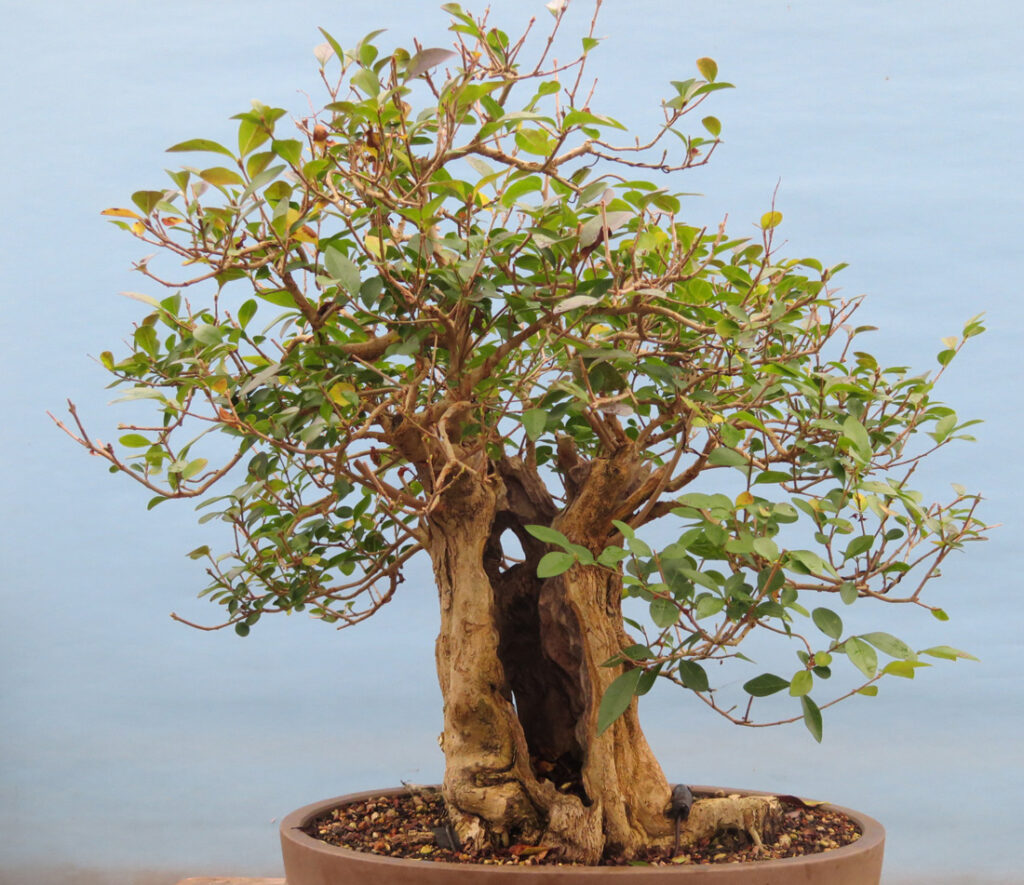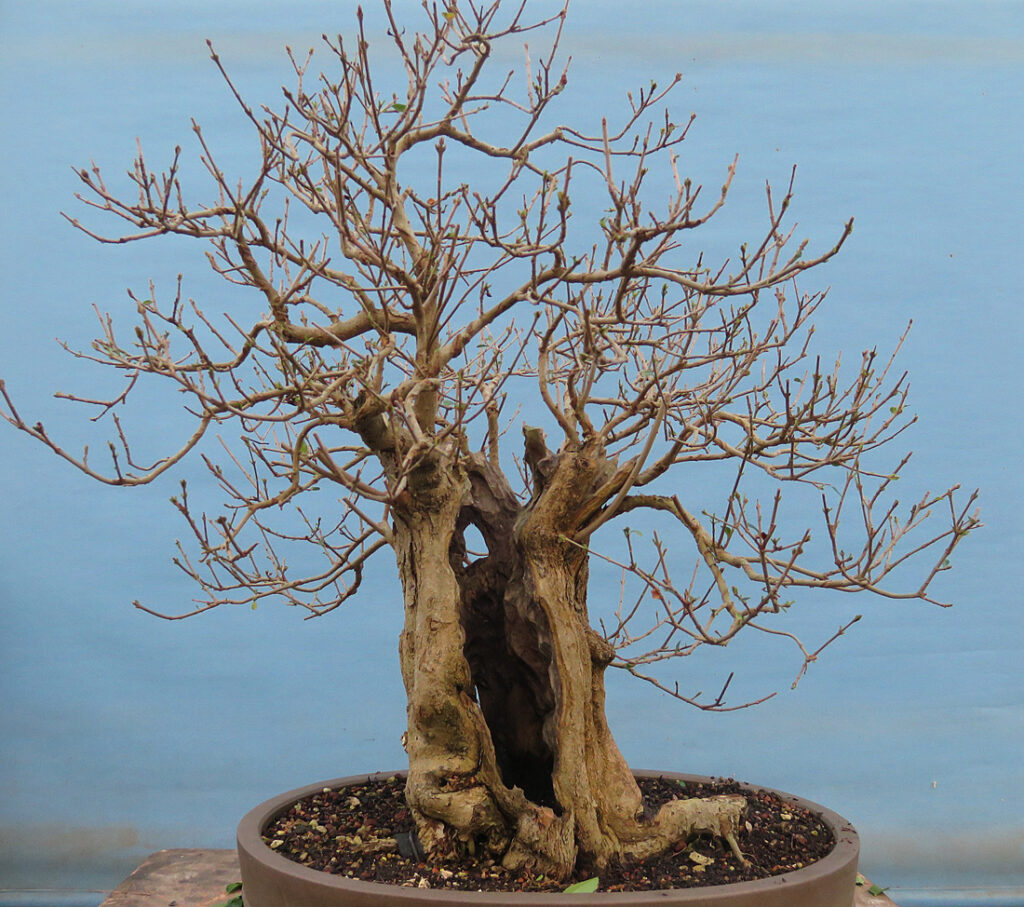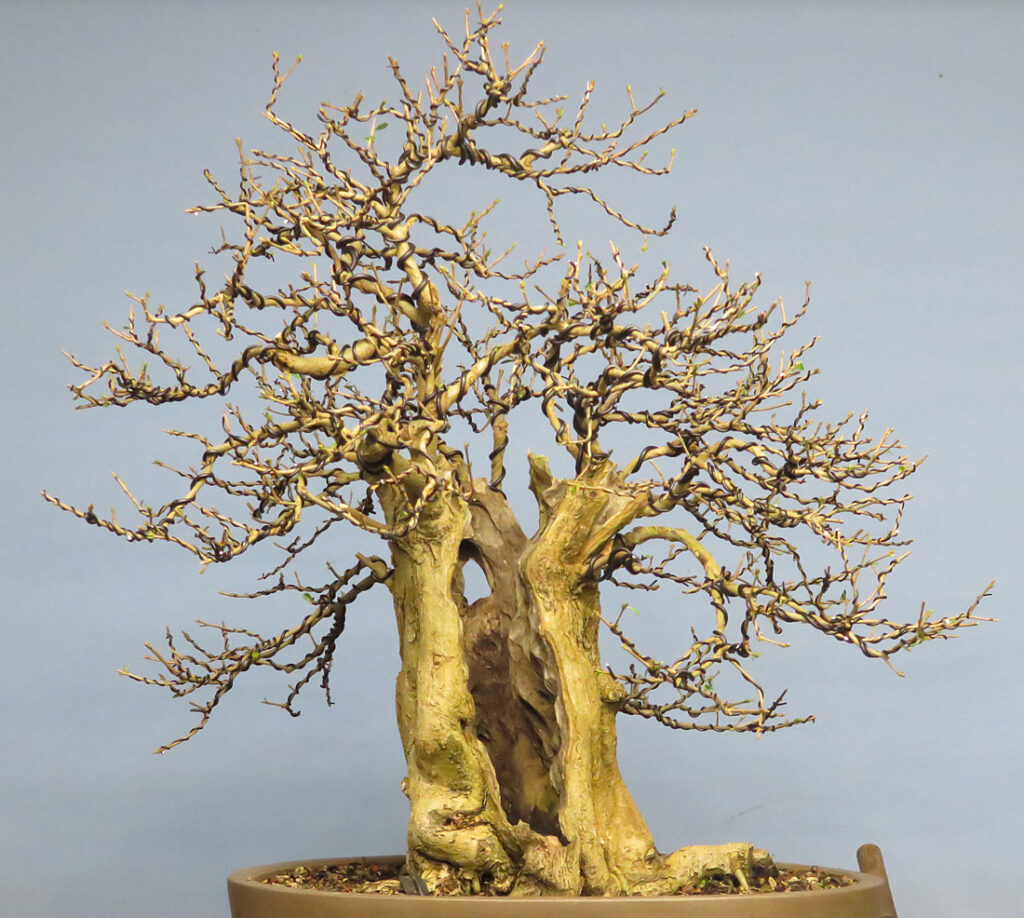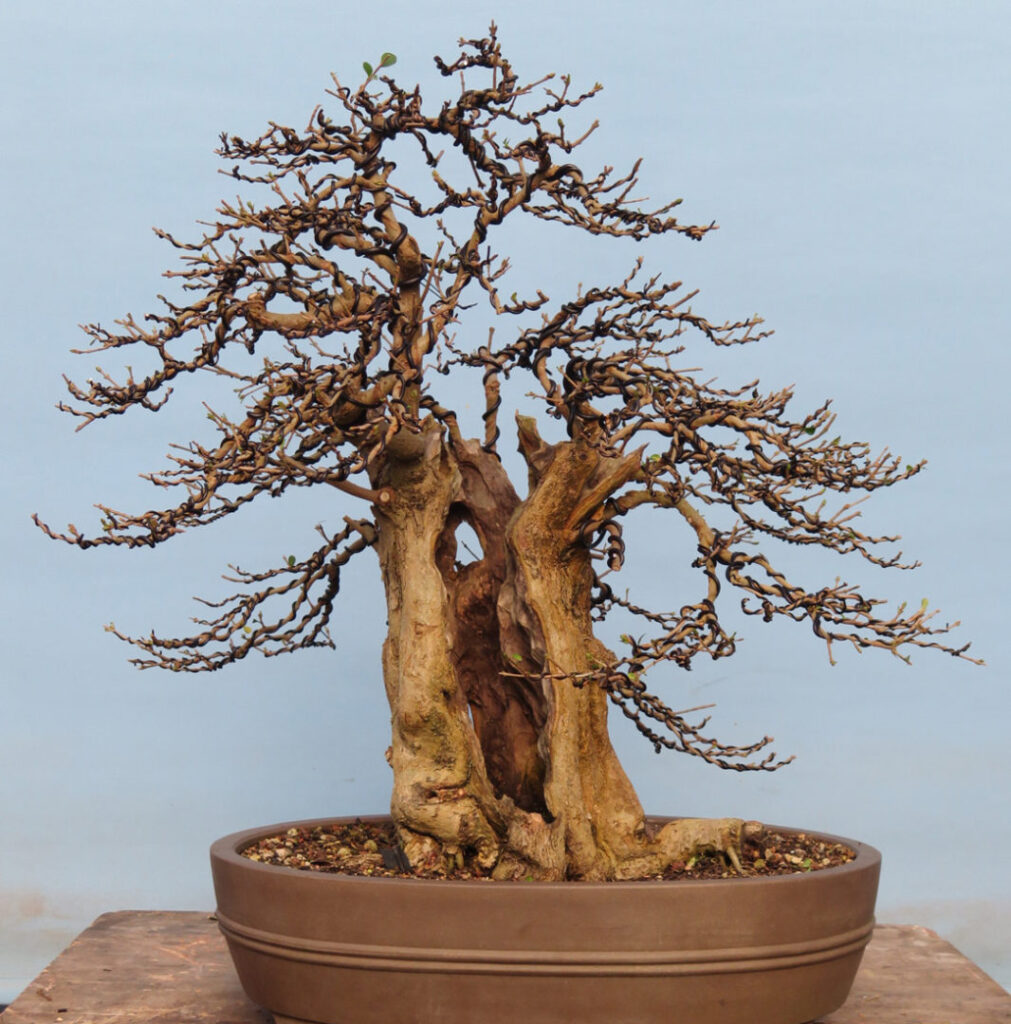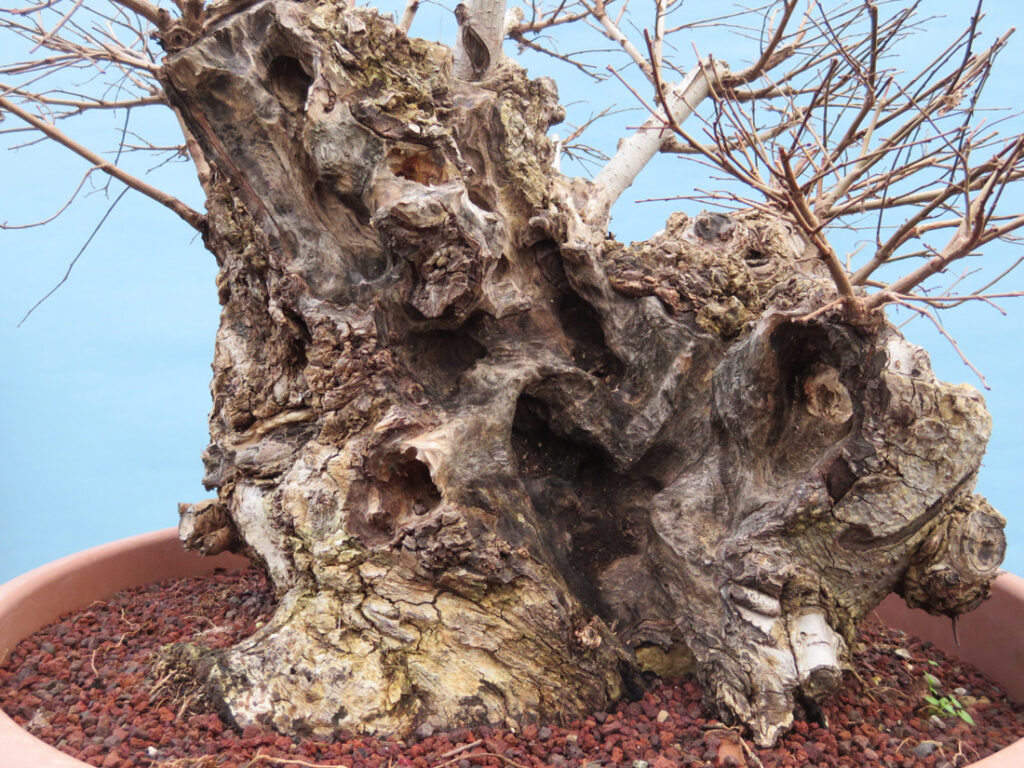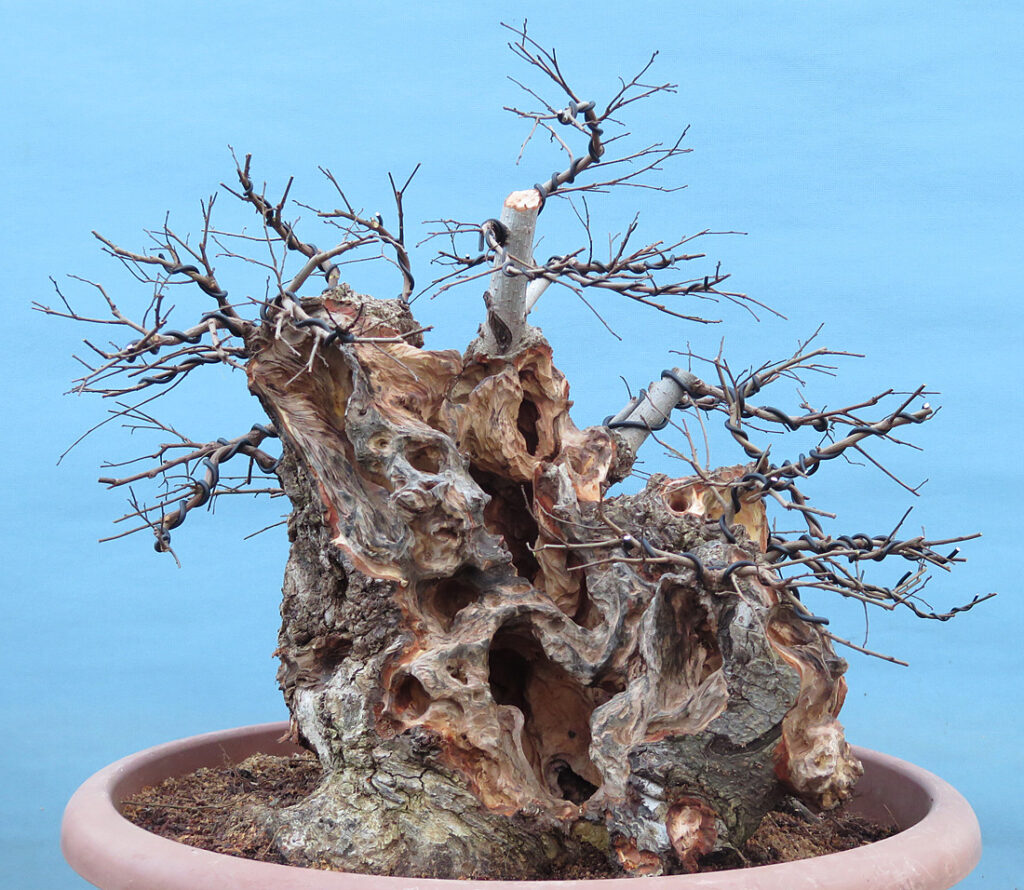Mar 8, 2018 | General
This week we took delivery of over 250 new trees. Lots of nice Japanese bonsai as well as Chinese, Indonesian and European materials too. I have tried to take a few snaps as I went through all this, sorry they’re not up to the usual standard but hopefully it gives an idea of what we have. This is, by no means, all we have coming but it’s not a bad start. There’s two more deliveries of yamadori planned within the next few weeks. Watch this space.
Next week i’ll start getting all this ready for sale and hopefully before the autumn it will have all been listed on the web site. Now that horrible weather has gone we will start re-potting in earnest within a couple of weeks. This bonsai lark never stops !
G.
Mar 2, 2018 | General
Way back when I started messing with bonsai I suffered serious bonsai envy when looking at the bonsai books I got from the library. The thing that impressed me most was the beautiful junipers I saw from Japan. Their stunning deadwood, contrasting red live veins and awesome foliage left me weak at the knees. Being in straitened circumstances I figured I would just have to content myself with admiring these beautiful trees from afar.
Part of the problem was that in UK bonsai the only source of good junipers at the time was from Japan. Most of them were eye-wateringly expensive and being nursery produced were also not exactly exciting. I remember when my best mate and I both managed to procure an almost matching pair of small Japanese needle junipers with good live veins and deadwood. We were both so excited we were ready to pass out. Being a couple of ignorant hicks we managed to kill the trees in pretty short order.
After that the only junipers I had were massive garden varieties with naff foliage or the ubiquitous Blaauws variety from a local grower. I did manage to produce some half decent bonsai from that material, in fact I still own one of them, but I was a very long way from my dream of a beautiful yamadori juniper like I saw in those old books.
Fast forward twenty five years and everything has changed. My circumstances have improved but those old Japanese masterpieces are hard to come by these days and command telephone numbers when they do become available. However my dreams have come true many times over thanks to the availability of the wonderful Spanish sabina juniper. I have lost count of how many of those beautiful gnarled twisty trees have passed through my hands now. The trouble these days is not the procurement of a wonderful tree but finding the time to do it justice. Junipers are extremely time consuming to work, particularly when it comes to first work.
If you have watched any of our videos about working junipers, read between the lines and you will see just how much time and effort goes into getting a sabina cleaned up, wired and styled. By and large we don’t do much work on our yamadori junipers, since I have to add an hourly rate to the tree afterwards the numbers just don’t add up. However this week I fell under the spell of one of these great trees and whipped it into shape.
Styling a juniper pretty much starts and ends with wiring and the better and finer the wiring the better the finished result will be. I particularly hate wiring junipers, my stubby fat fingers don’t lend themselves to fine work but sometimes we just have to knuckle down and get on. The only thing worse that wiring a juniper is wiring a juniper at five degrees below freezing, which it’s been this week.
This juniper has been sitting around now for a couple of years and it was just at the point where, if it were not worked, it would begin to go past a point of no return without a brutal haircut. So a few wire brushes and a half pound of copper later and here it is…….
G.
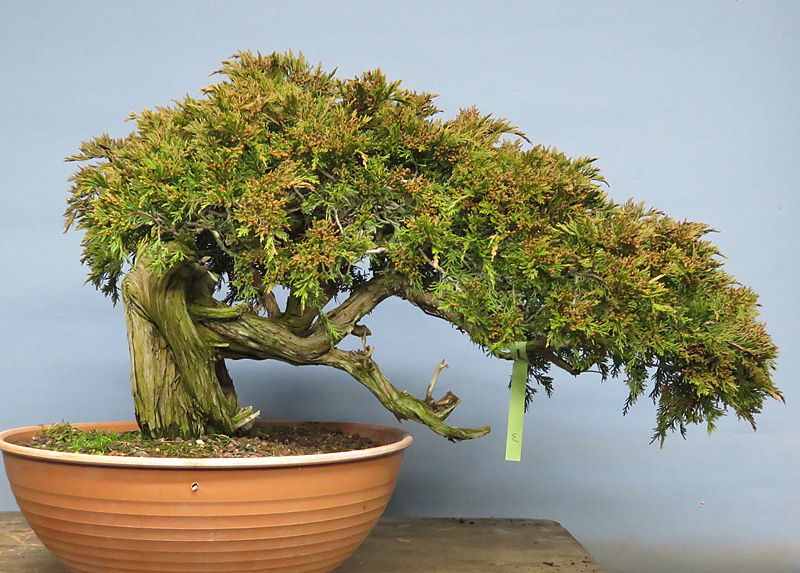
Spanish sabina on Saturday, in from the snow.

Friday afternoon. It’s been a very cold week, work progressed slowly! Sorry the picture’s not great my poly tunnel is covered in snow.
Feb 27, 2018 | General
Over the next few weeks we have our largest influx of bonsai ever arriving on the nursery. By May we have close to £75,000 of bonsai trees and yamadori arriving right here. Today, despite the weather my first stock arrived at 7am. To be fair this is probably the worst of what we have bought and much of it we have long term plans for but because bonsai moves so slowly I have to be thinking several years ahead all the time. There is some very good value here too considering how hard it is to find small material suitable for training as bonsai.
Please don’t bug me about prices. By summer some of these trees will begin to make their way onto the web site. I have over 500 trees on the way as well as 450 existing trees to re-pot once the weather breaks and won’t have time to be messing with emails, sorry. These days selling bonsai is very easy, the hard bit is getting it in the first place and I have to work a lot harder that I used to in order to keep our benches full.
Next week Japanese trees arrive 😉
Meanwhile if you have any trees available for sale or exchange, particularly large numbers PLEASE get in touch.
G.
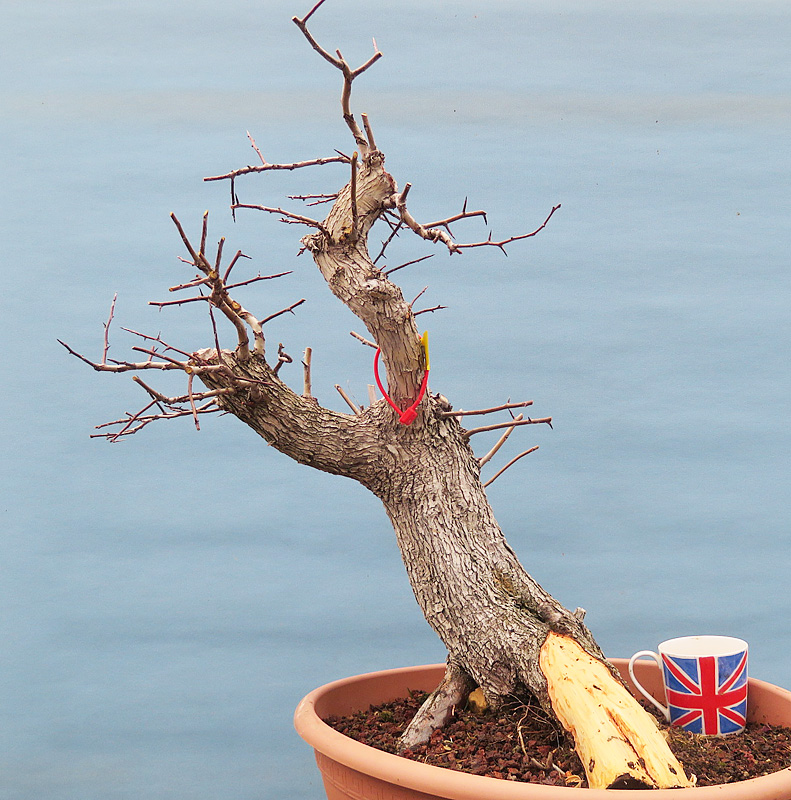
Hawthorn

Quercus faginea
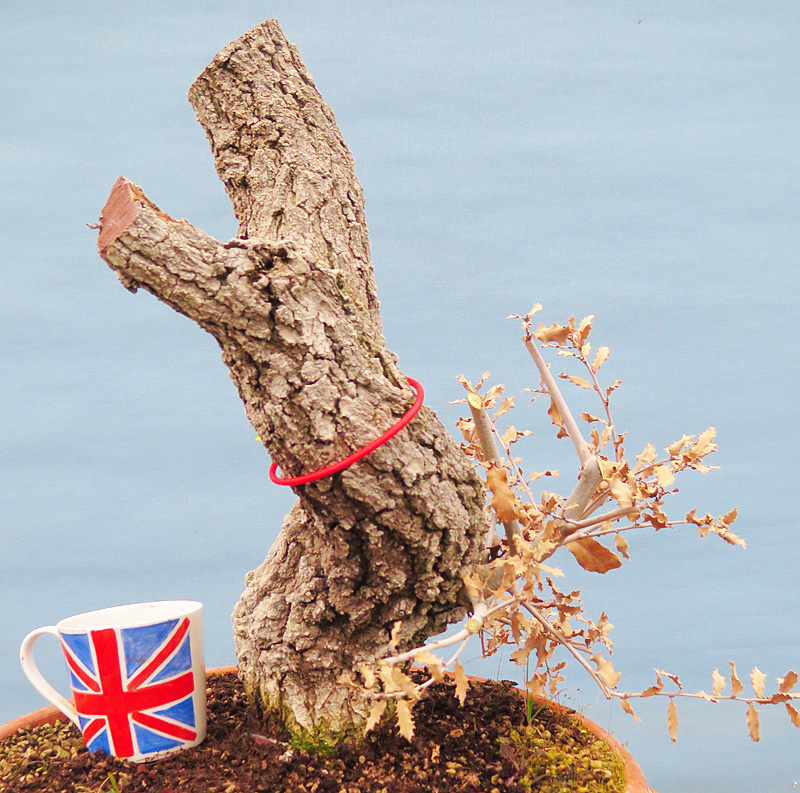
Quercus faginea
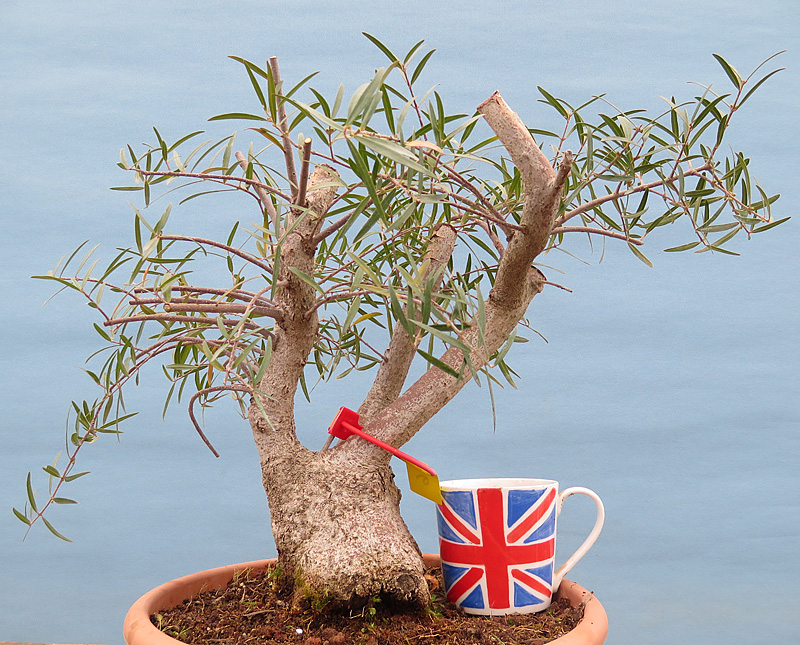
Anyone have any idea what this is?

Quercus suber
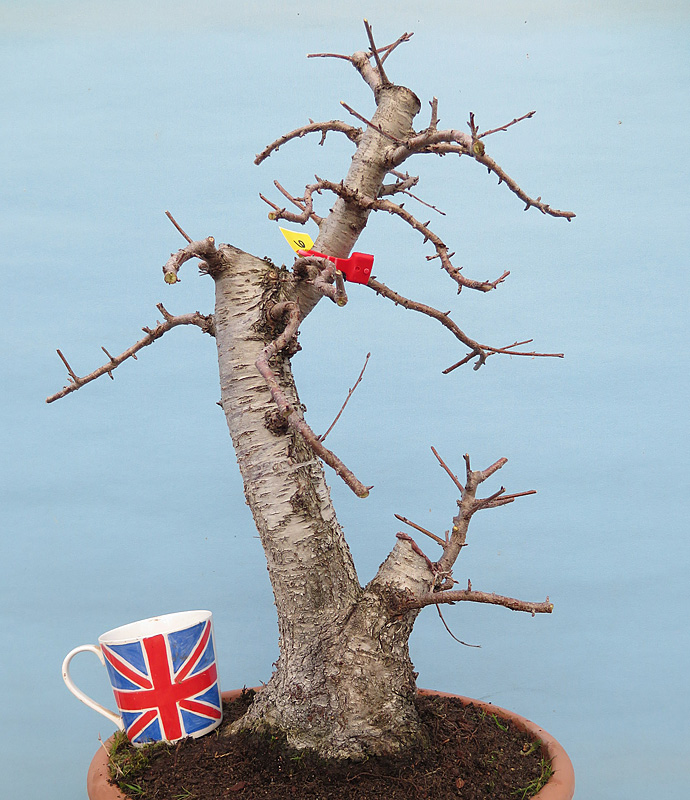
Prunus mahaleb

Pistacia
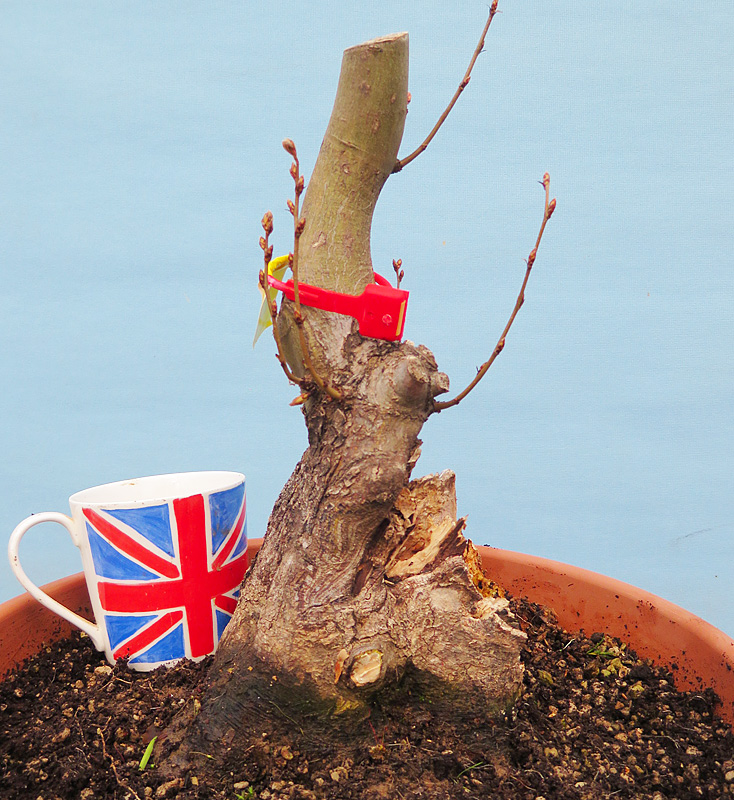
Carpinus betulus

Carpinus betulus

Carpinus betulus
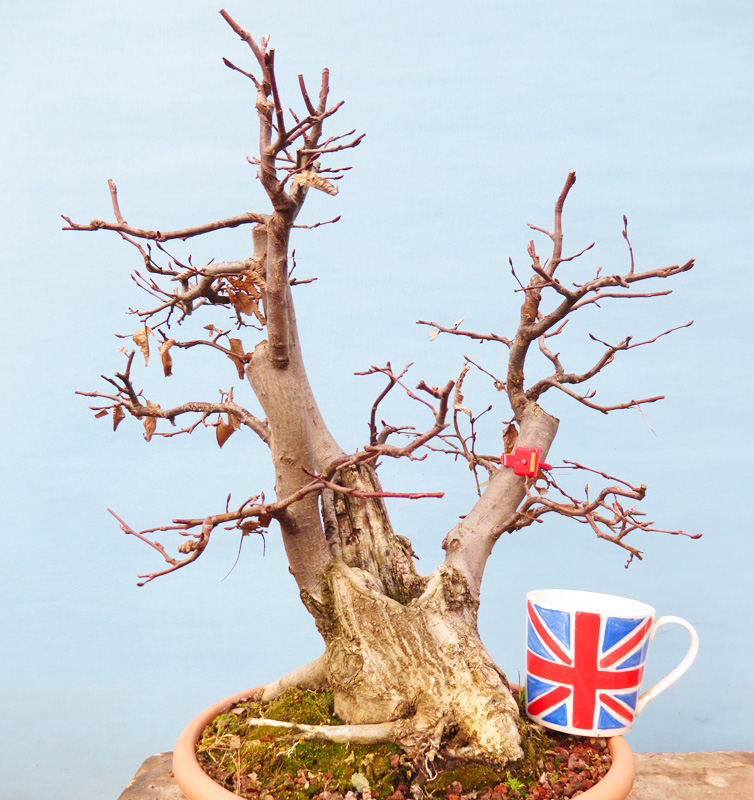
Carpinus betulus

Carpinus betulus
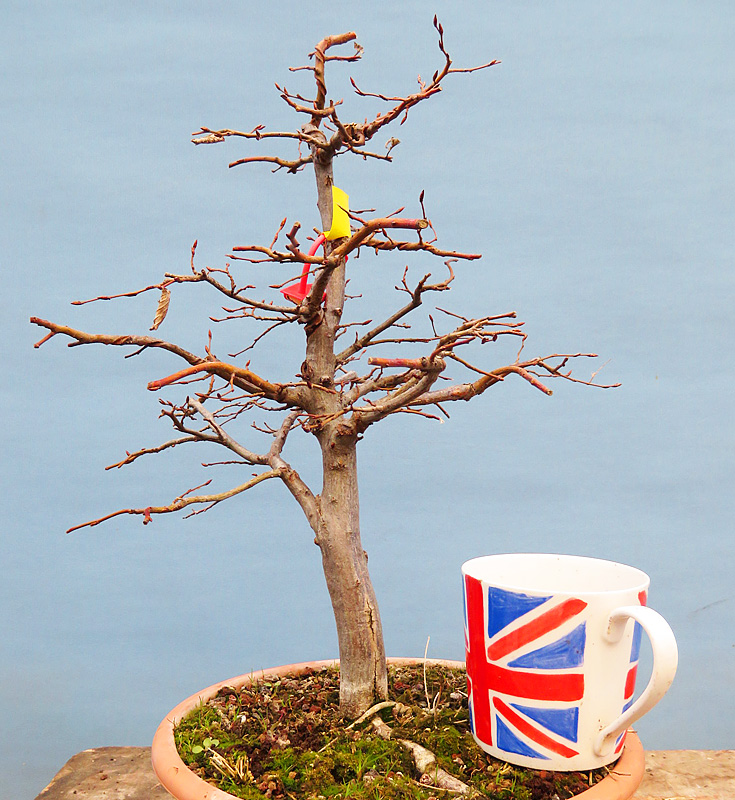
Carpinus betulus

Quercus faginea
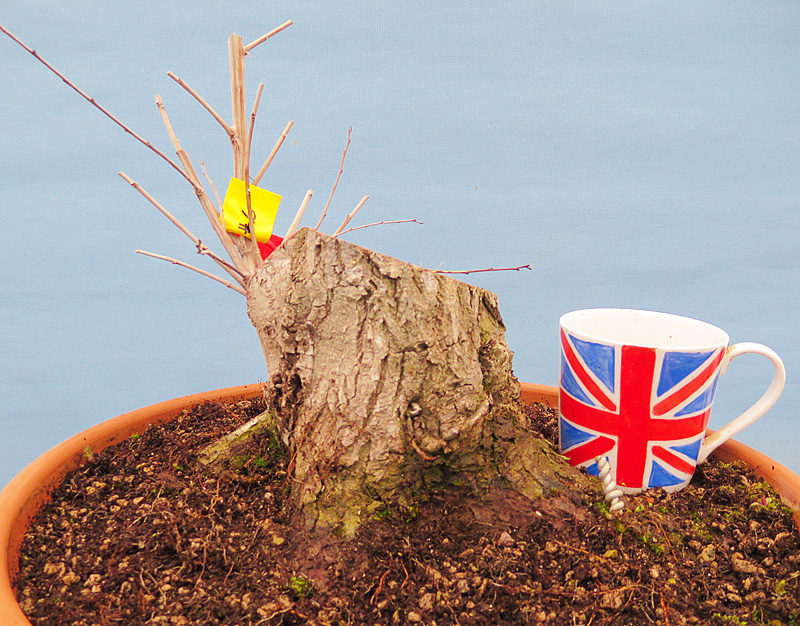
Ulmus minor
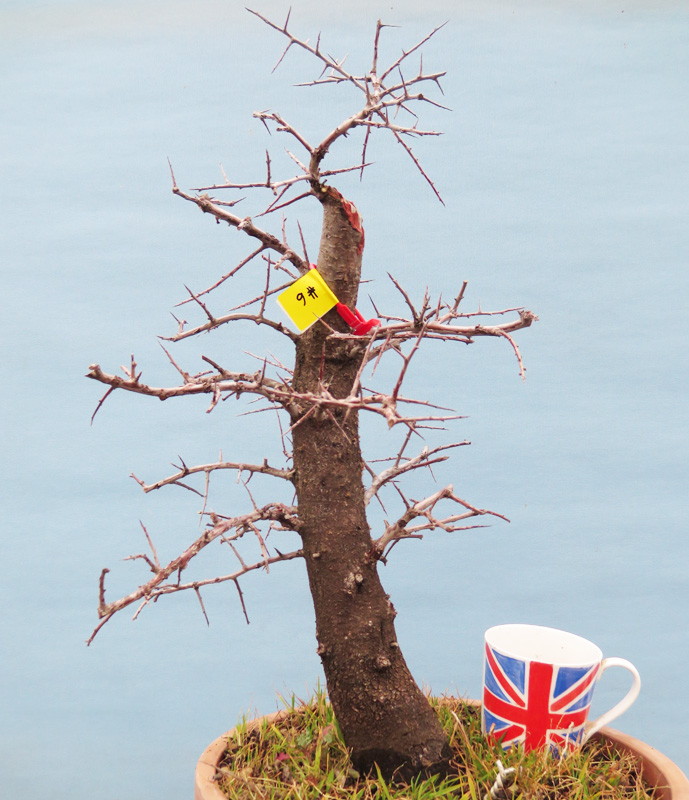
Prunus spinosa
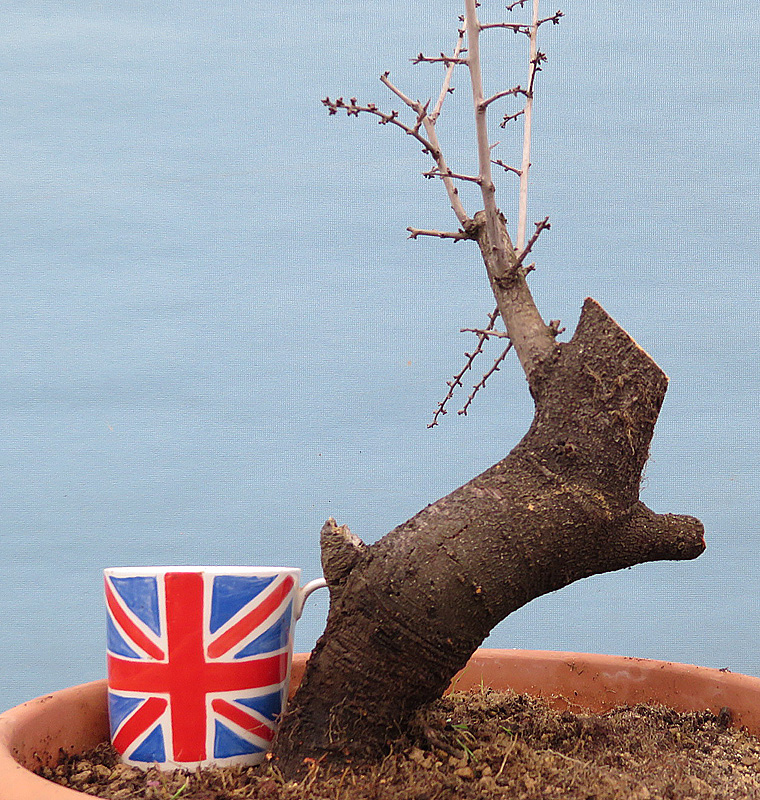
Prunus spinosa

Prunus mahaleb
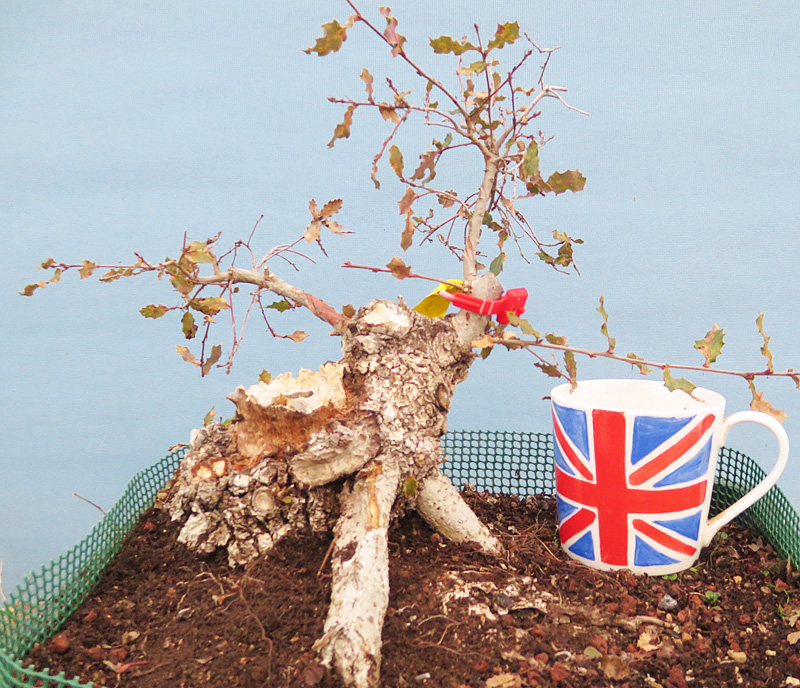
Quercus faginea (mostly buried)

Juniperus sabina
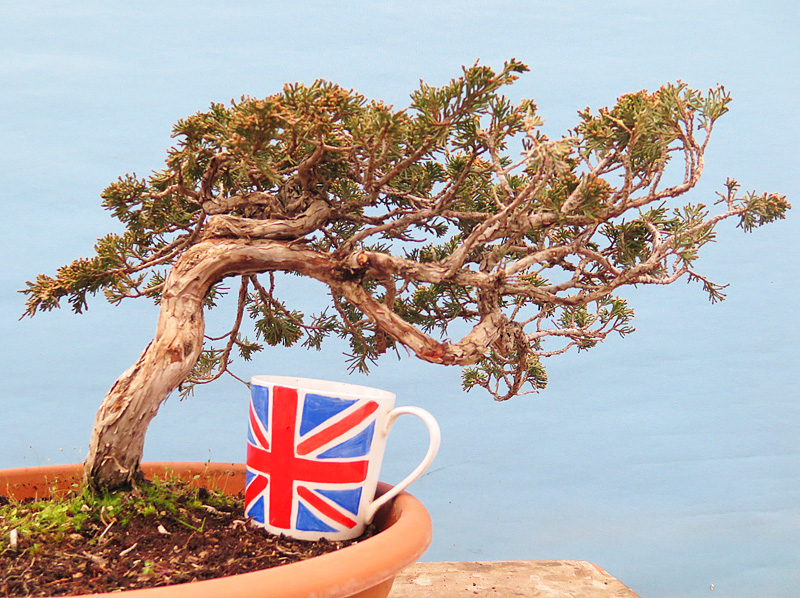
Juniperus sabina

Juniperus sabina

Picea abies
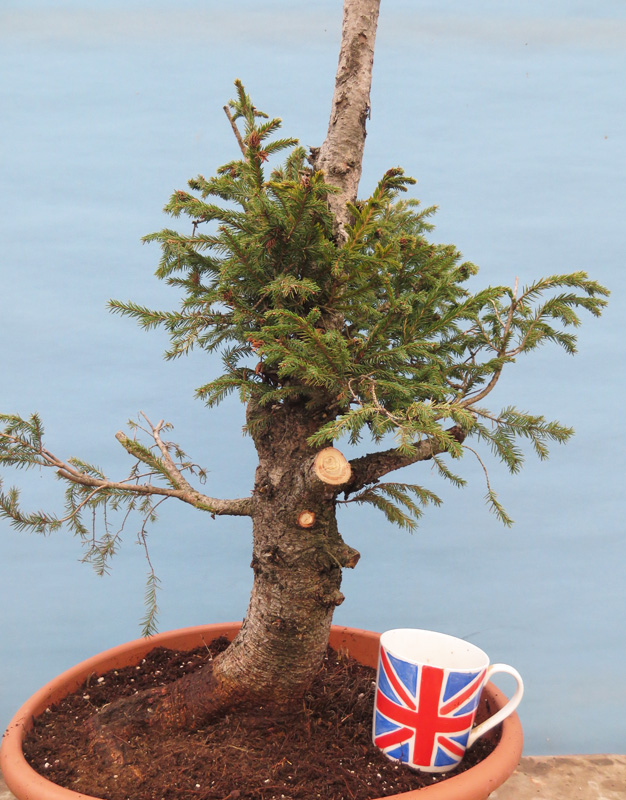
Picea abies

Tamarix
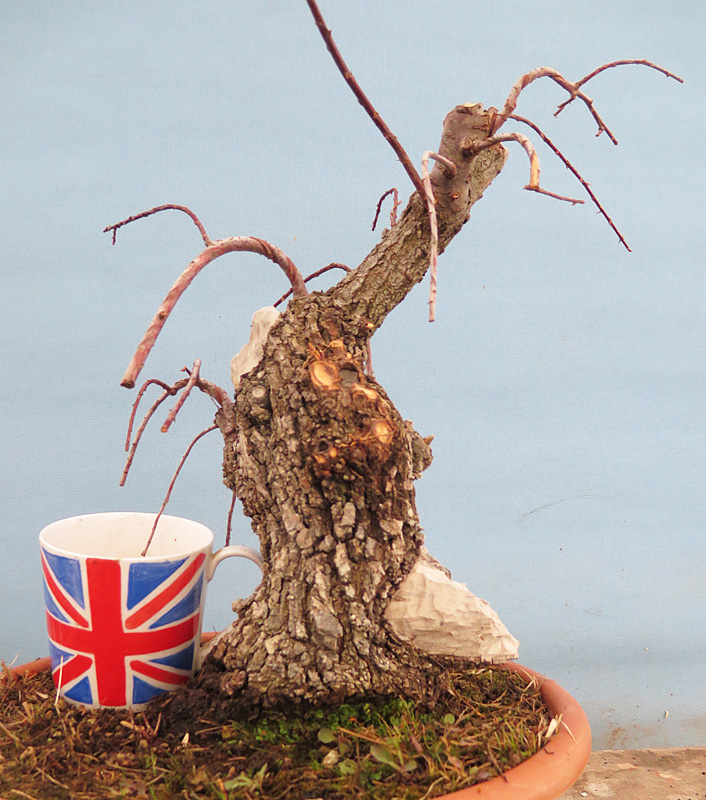
Tamarix
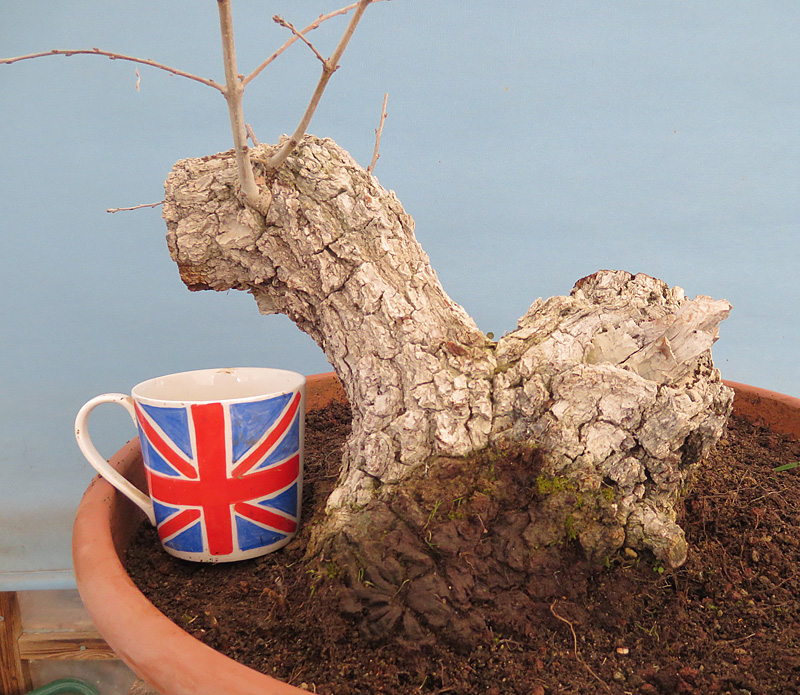
Quercus faginea
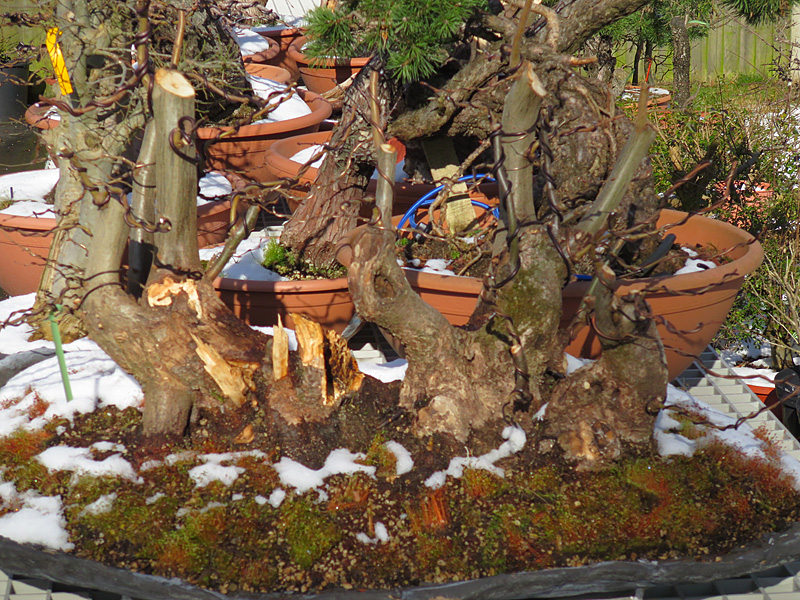
Massive carpinus betulus raft.
Feb 23, 2018 | General
Ever since I was a toddler I have been something of a loner, definitely NOT what you would call a team player. Most of my early years in bonsai were spent entirely on my own, no mates, no bonsai clubs and nobody pointing me in the right direction. The net result was a whole host of bad experiences. I can confidently state I know a thousand ways to fail at creating bonsai trees. It took me ten years to even start to figure out what I was doing, some would say I haven’t figured it out yet but I never really bothered about what other folk thought.I know when I did a good job and come the day I actually do achieve my best work it’ll be the last bonsai work I ever do since I have no interest in going around in circles.
When we start out we all make some ugly trees. Most of mine died, some I killed and a few I took out to the woods and planted them there where nobody could see them. These days, because we move a lot of trees throughout the year I have a huge number of plants coming across my bench. We get a lot of waifs and strays, a lot of abuse victims and even a few terminal cases. My log burner always has plenty to eat and the composting bins are always full. I am never shy in administering a coup de gras (1. A deathblow delivered to end the misery of a mortally wounded victim.) However one of the things I particularly hate is having to make good on other peoples half work. There’s nothing I love more than a good clean stump but putting right something that has been tickled by someone else annoys me because most of the time it crimps my style, I don’t like to be told what to do.
Late last year I took delivery of a large number of trees from a European supplier. This particular tree is a prunus mahaleb, a superb variety entirely brilliant for training as bonsai in Britain as it’s ability to withstand shit weather and abuse is legendary. Nothing seems to get the better of this brute other than a chip storm created by a bonsai guy with a Makita. I can’t blame the guy who worked this tree he’s just doing what he was told by his boss but I can’t say the work increased the commercial viability of the tree. The trouble is bonsai takes and age to produce and quality work takes time and that costs money which nobody want’s to part with. As a result we either get very beautiful and expensive Japanese bonsai or this sort of ‘rough’ stump work. Having parted with my hard earned in exchange for this bit of badness it became very obvious i was going to have to dig deep in order to salvage what was left and I wouldn’t be taking home a pay check that week.
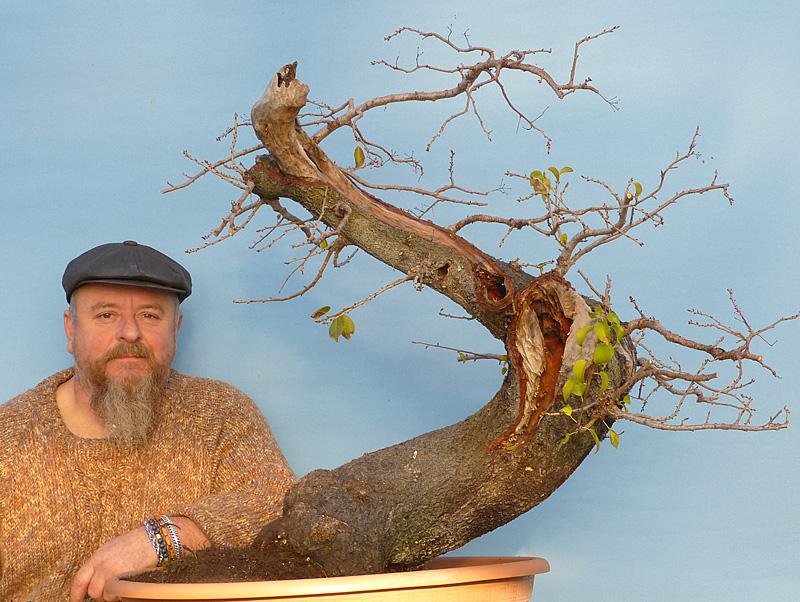
As it arrived, to say i was disappointed would be an understatement. Look closely!
There have been some stumps that have obviously been chewed out around the half way line. A straight line was run up the second half of the trunk where a big ugly lump was left. Several bits of poor technique with little hope of reconciling the whole. That’s the trouble with this type of hastily conceived work it often leaves us with worse problems than if it had not been done at all. The only way to progress is to build the tree one small step at a time. Piece by piece we can try to absorb the ugly and with patience, hopefully, we can heal the tree then, over time, as the tree grows and develops all can be well, if we’re lucky.
The first thing to hate is the haphazard ramblings of a carving tool. NEVER put a carving tool on a tree unless you are entirely aware of what it is you want to make. The inherent nature of a carving bit is to tear everything to pieces, just ‘following the tool’ will wreck your tree and everyone will instantly know it took two tools to make that mess. With a really big tree like this prunus you have a great opportunity to do something good. That trunk is a foot thick, carving a half inch up the front looks lazy, ill conceived amateurish and on a good day, SHIT. Carving has to belong to a tree, not look like we did it with a magic marker. Carving a big trunk and achieving a deep well connected and beautifully shaped hollow takes a lot of time, a lot of tools and a lot of skill and if it’s done right nobody will suspect it’s not natural, at least not after a few years. That type of work is all about light and shadows and making that work means some deep holes. From the half way point downwards the trunk is now entirely hollow and light breaks through in several places and all told that took about eight hours and filled my industrial vacuum cleaners bin three times.

The lower half of the trunk conceals most of the work completed here but in the flesh it bings a little fizz to the tree.
Sadly there was nothing i could do with that long straight piece in the upper part, there was nothing left for me to use so all I could do was lighten it up and clean it nicely. At the top we have that ugly knuckle and that can be fixed. However due to some suspect material preparation in the past there’s a whole ‘Medusa’ thing going on behind that ugly fat slug of wood. Everything’s in the wrong place and the ugly’s knee deep.
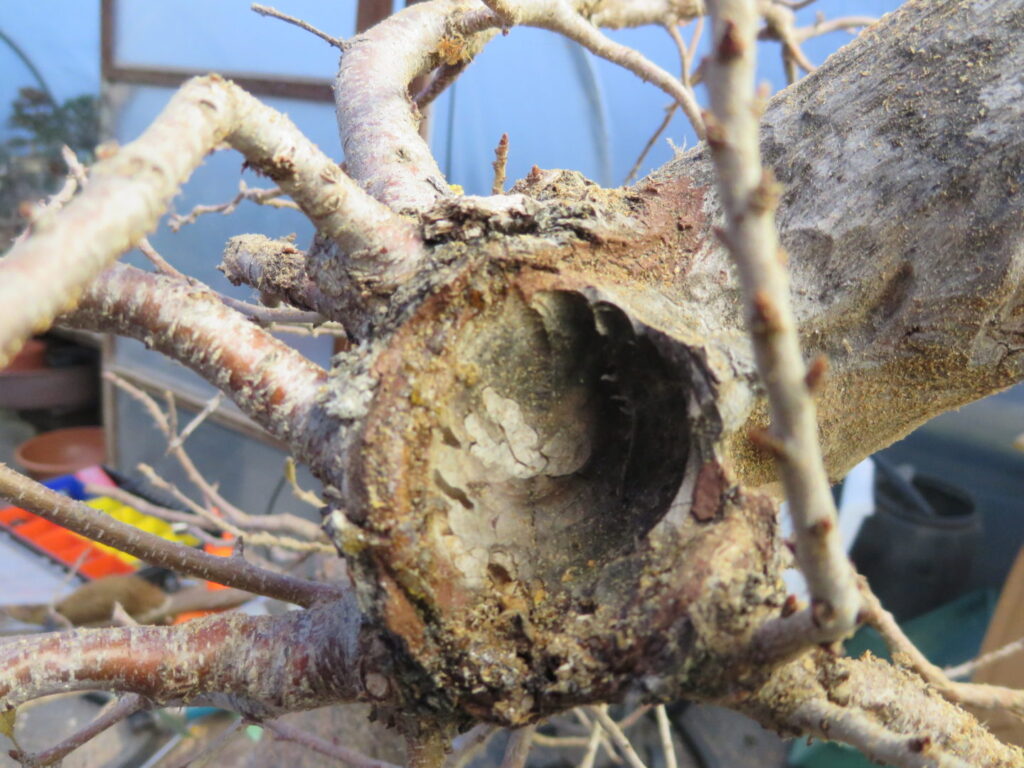
Carving, that’ll help.
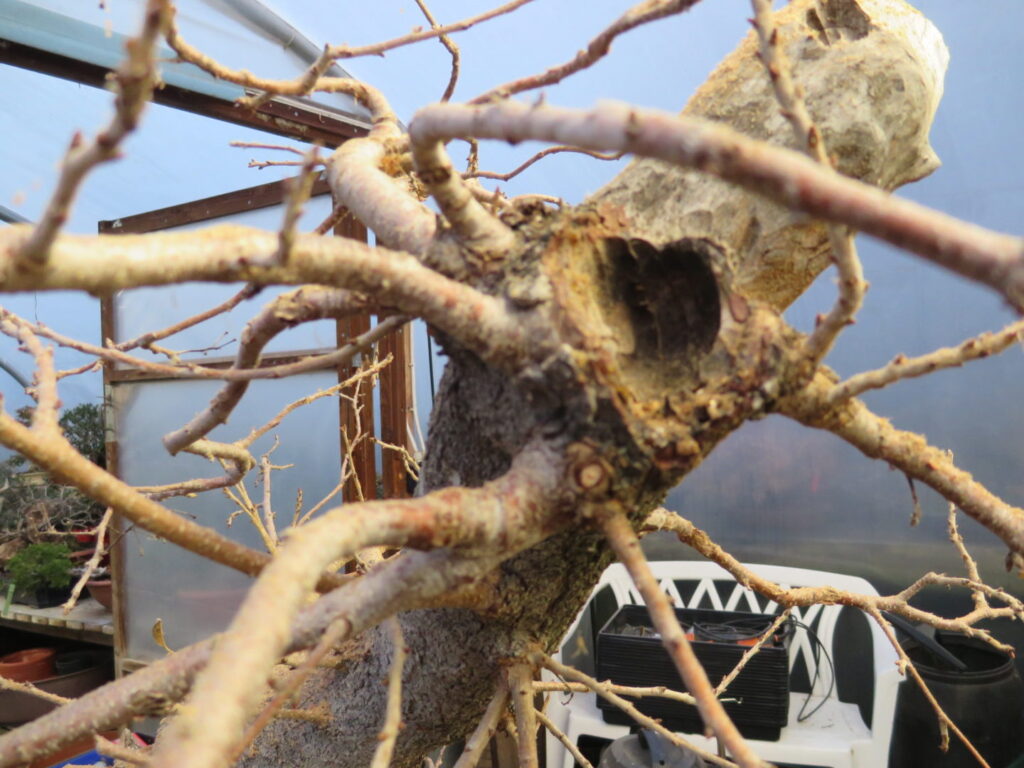
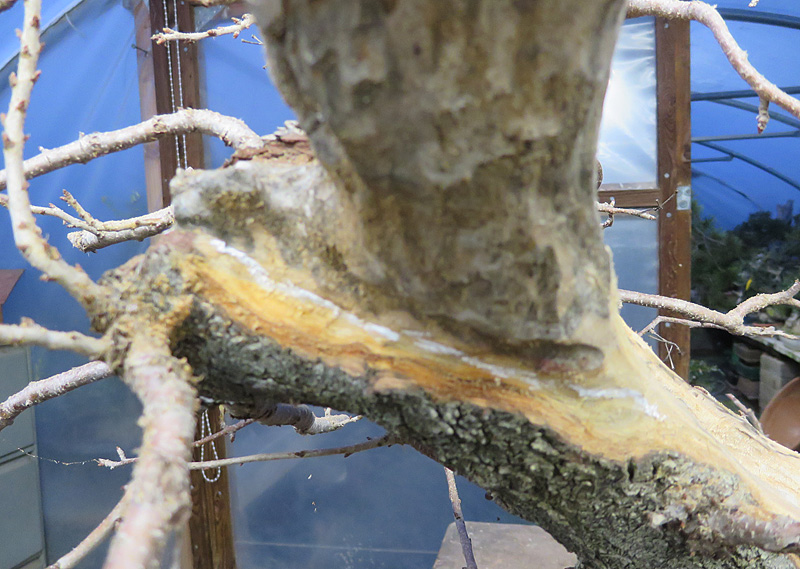
This chalk line’ll fix it.
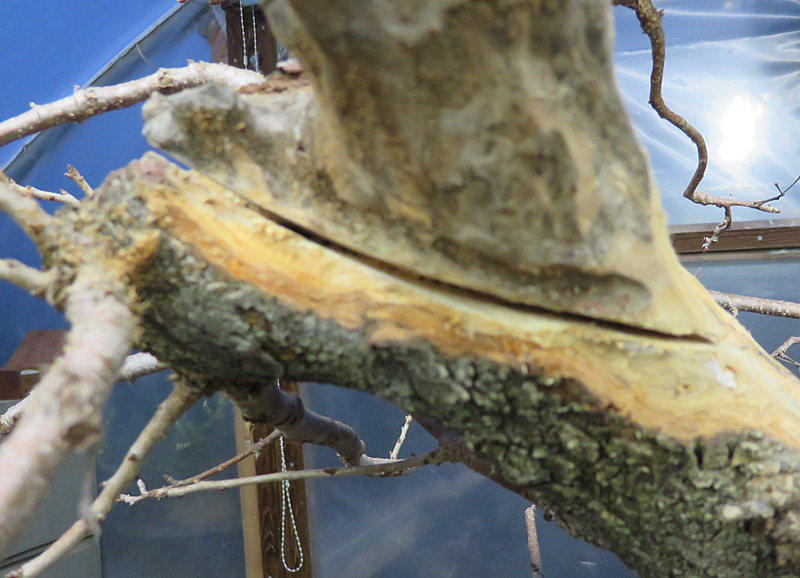
Splitting this bit off the main trunk enables us to improve the movement and taper. It’s not much but it’ll help.
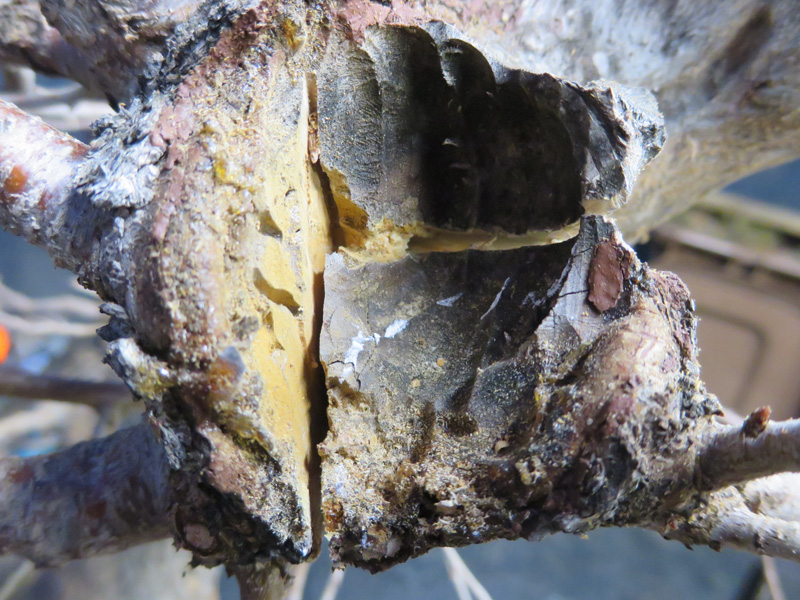
With the saw cuts in place I just have to remove the inner wood before pulling that lower corner into place.
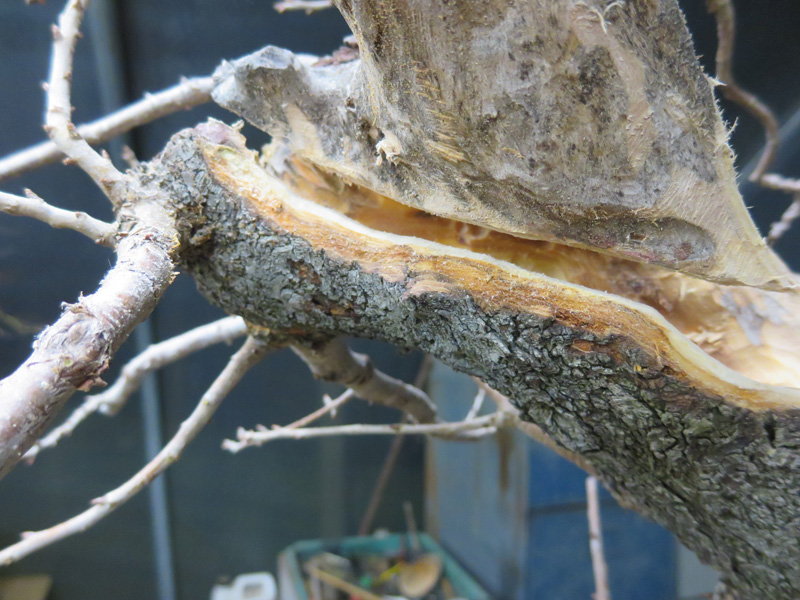
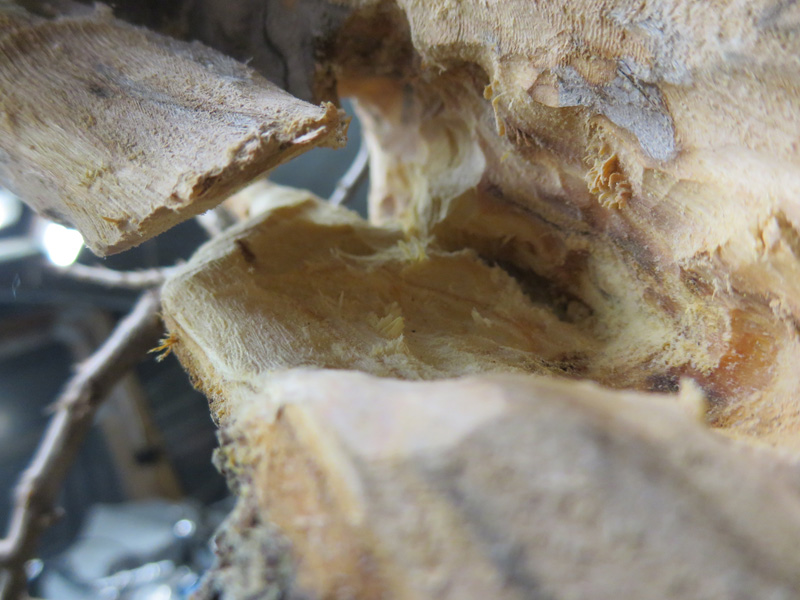
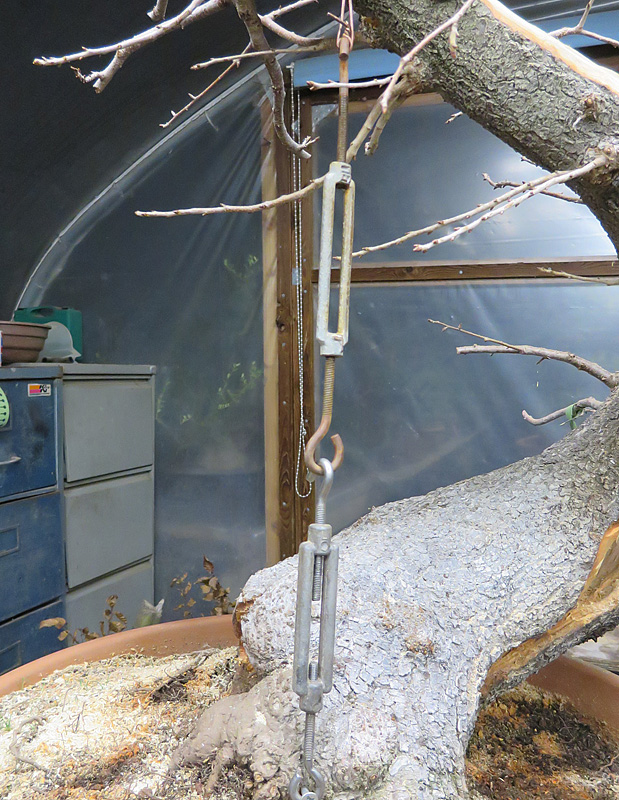
Two turnbuckles gives us a nice long pull


It took a while to set this up but once the live bit was pulled away from the main trunk I was free to get rid of a bunch of superfluous wood. I thinned out the banana at the top before going off sick for a month from the strain. I still think that lump needs work but will see how it goes. With some ugly wire and a bit of rough texturing on the surface wood i think this tree is showing a little more promise than it did. Hopefully a summers growth will heal it further. For sure I will never see my two days work come back to me but that’s compensated for by the warm fuzzy feeling of having helped this tree back from the brink. After all we do this for the love of it, don’t we?
G.
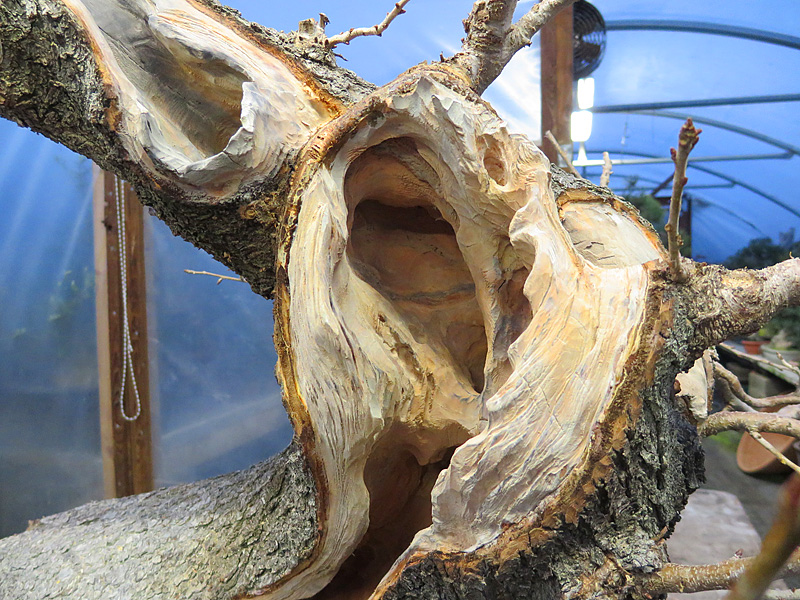
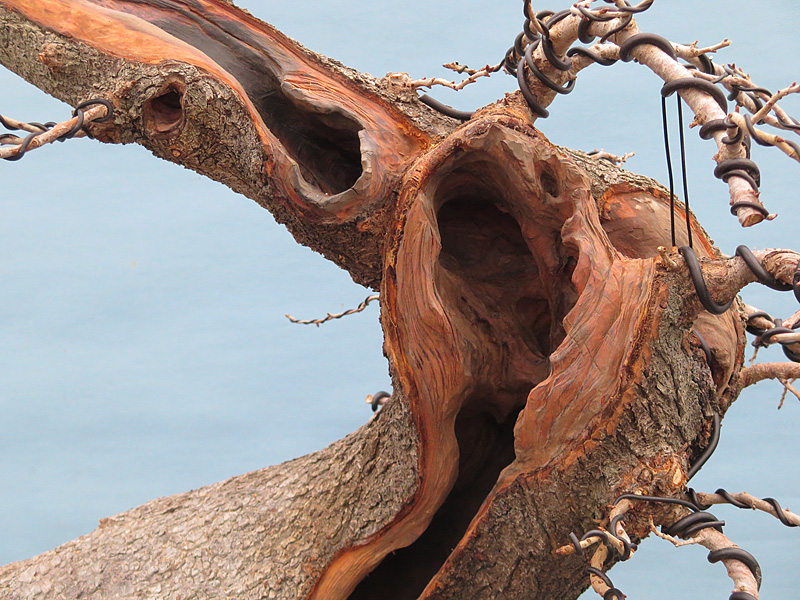
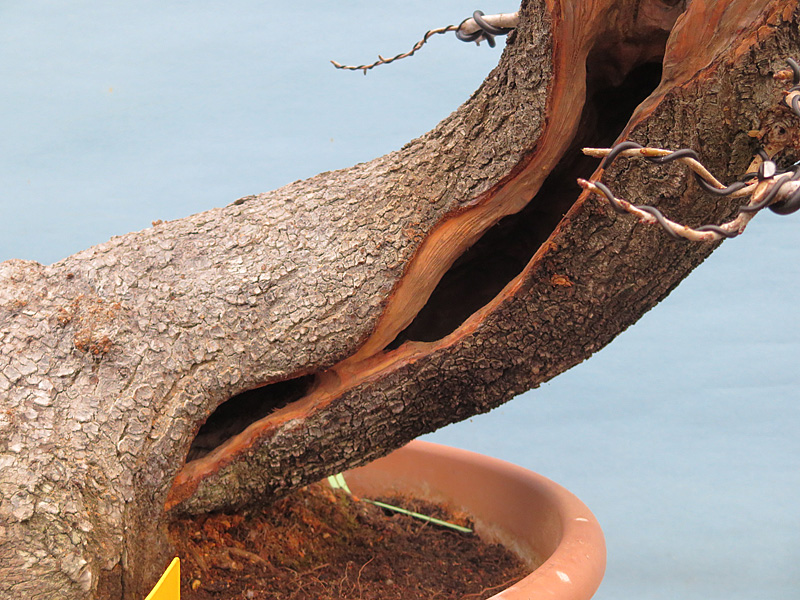
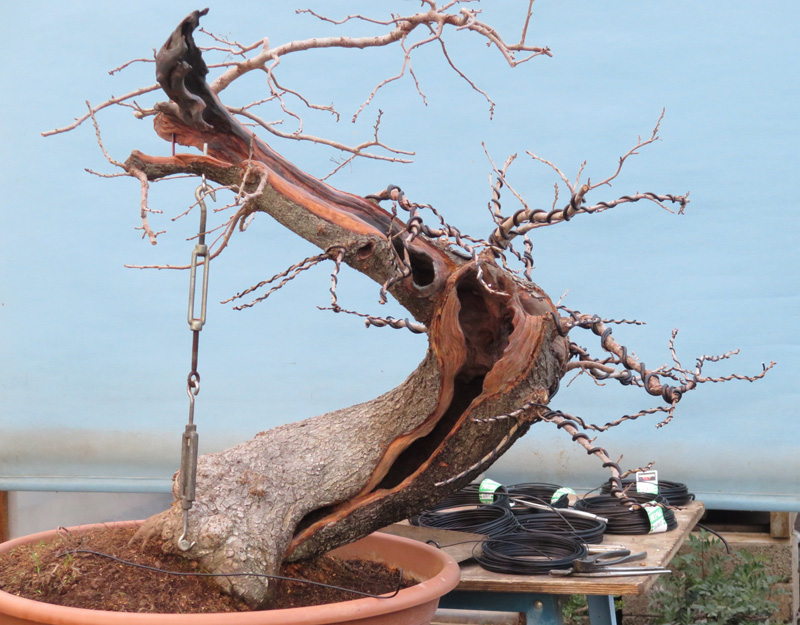
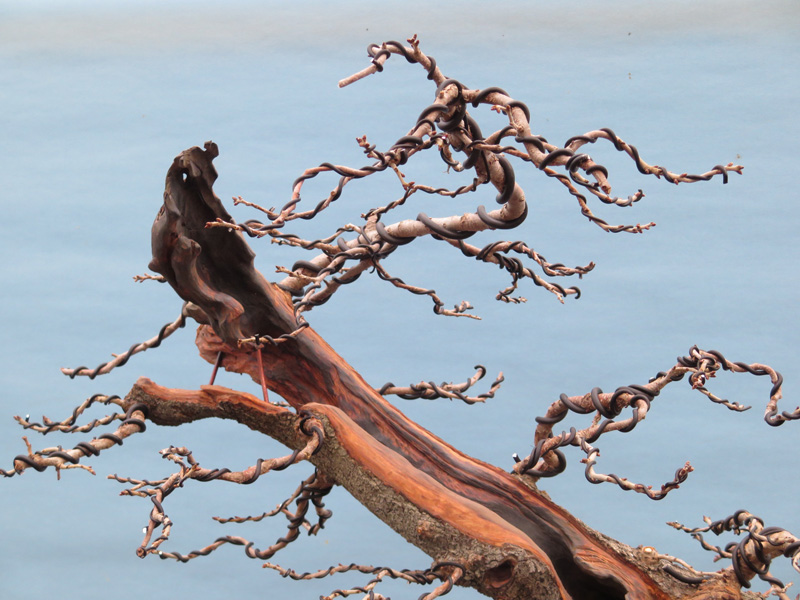

Feb 20, 2018 | General
In the horticultural world the subject of plant pest and disease is often known as P&D which is what I will refer to it as forthwith because I am not a good typist. Over the years my position in the bonsai world has been elevated, partly by some good work, and partly by the opinions of some nice kind folk who like me, or much more likely, like what I do. Thanks to those wonderful folk I have a voice and with it I like to pass on the benefits of my, now extensive experience. I like that I can do this for free too, so please keep buying your bonsai supplies from Kaizen Bonsai and I will keep writing 😉
One of the big problems I have with my slightly elevated position is that I am called on for advice daily. This can be a big problem, spending an hour on the telephone every day is extremely inconvenient especially when I am paying for the call. I need one of those premium rate phone lines then I can retire and just sit in my old armchair chatting all day whilst drinking tea and talking bollocks. However, one thing this does allow me to do is become familiar with the problems folk are having with their bonsai. I don’t do social media and so this is actually one of the upsides of my hours spent on the blower.
Before I get into todays subject I have to just pop up onto my soap box here for a moment and vent a little…… I heard on the news recently that UK doctors are having problems with patients coming in to see them and having self diagnosed via the Internet of Cobblers are ignoring advice and demanding medications with, to sane people, obvious potentially serious consequences. I think I am on safe ground here when I say there is more sh*t on the internet than quality factual information. The nonsense, fake news, dishonest advertising, hyperbole, lies, hatred and insanity are a blight on the human race, by and large. We claim to have ‘evolved’ into something so clever and all knowing but seem entirely incapable of seeing our own stinking stupidity. The future of the human race on earth may well be shorter than the life span of our bonsai trees.
As a person who thrives on new challenges I am always up to something new. I spend a great deal of time on the web, sifting through the BS, learning new things I then go out and practice in order to perfect in the real world. With my, now, half a century of life experience I can apply a certain level of good old fashioned common sense I learned from my father and grandfather in order to filter out the attention seeking gobshites and the snake oil salesmen, with a little work I quickly get to the genuine folk who are good teachers expounding their real world skills learned over decades. Last year I learned how to use a metal working lathe and whilst it is an ongoing project I have, even though I say so myself, knocked up some very nice looking, functioning motorcycle parts and carving tool prototypes. In the past I learned hundreds of things from traditional lime plastering, various forms of welding, making Damascus steel knives to recreating 70 year old motorcycle wiring, fitting and removing big tyres, timing camshafts and sharpening straight razors. In fact I would say my most engaging hobby is learning new things. It is beyond me why so many folk only us the internet for entertainment and upsetting each other on social media (antisocial media?) which I purposely avoid like polonium tea bags. An opinionated old duffer like me is just going to get in trouble.
Please stick with me here, I have not forgotten my thread, it’ll be worthwhile when we get there. So, I think we can say the internet is good for at least three things….
- Upsetting folk we hardly know.
- Baffling ourselves with bullshit.
- Learning valuable new life skills.
- Finding out really helpful information.
I know I said there were three points but once I got there I thought point 4. was important too.
Going back to doctors, or at least the point I was making. If you have a symptom and look it up online chances are, within a few minutes, you will be very close to your last breath. People like to exaggerate and since grammar has begun to loose it’s power everything has been taken “too another level”. The modern tendency to use a sledge hammer to kill a fly means so many things are presented as so much worse than they actually are. Add plagiarism into the mix and the constant re-publishing, amendment and exaggeration of fundamentally flawed content and you have the ‘nutters running the nuthouse’ to quote a very non PC phrase (of which I know many and yes I know mental health issues are not a laughing matter). We end up where a patient sits there telling a doctor his job and sues the doctor when they don’t get there own way. Who DID open up the doors of that nuthouse?
This relates very powerfully to bonsai and IN PARTICULAR to P&D. As an example. A few years ago I sold a very expensive piece of Italian yamadori to a very good customer of ours. The tree did all the right things and with some outside help our guy was bringing this tree on in leaps and bounds. I bumped into him over the winter and he asked me for advice on his tree. He shew me a picture of some pretty fungi (mushrooms) growing around the base of the tree. Leaping to the conclusion that all fungi are the end of all life he panicked. After posting the images online he was advised (this is true!) to burn the tree. Seriously, I have heard some incredible shit in my time but this has to take the prize. Why would you burn a very valuable, beautiful and important bonsai tree because a few ‘shrooms’ appeared out of it’s soil? Who made the leap from mushrooms to such a virulent destroying toxin that fire is the only answer?
As it turns out estimates suggest there is more life buried underneath the surface of the earth than exists upon it’s surface. Kingdom fungi is the largest and most diverse group of organisms on earth with an estimated 2.2 to 3.8 million species of which less than 5% have been identified. A large proportion of those species we have identified have proved problematic to plants, which is why we have spotted them. However by far and away the largest proportion get on with their daily existence unnoticed and of little consequence to anybody.
Fungi are important. Because they do not photosynthesize their energy needs from the sun like plants do they have to gather their energy from other sources. By and large this is from dead organic plant matter. Some also work with plants in a symbiotic relationship, promoting plant growth whilst taking a little for themselves. Fungi, mostly, work tirelessly recycling organic rubbish, extracting energy from it and returning the rest back to the ground for re-use. Without fungi the world would be miles deep in dead vegetation and organic waste and the soil would be incapable of supporting plant life. All life on earth is dependant upon fungi doing their jobs. Sure there are some rogue elements that can cause harm but these are in the minority.
As humans we fear what we do not understand and seek to destroy those things through fear. As kids, fearful parents instil in us a sense of fear to do with any type of mushroom or fungi. Pretty red mushrooms look very appetizing to small kids and it’s probably a good idea to keep the two apart. However later in life that fear stays with us even though, as it turns out, most red mushrooms are Ok to eat. The most dangerous in the UK is probably one of the most beautiful pure white mushrooms, the Destroying Angel (amantia virosa). Don’t eat this! In fact don’t eat anything you find unless you are familiar with what you have but don’t also assume that all fungi are bad, either to eat or for the health of your garden or bonsai trees. By and large fungi, like most P&D only attack plants that are weak, distressed or in some other form of environmentally induced weakness. Much like people, healthy specimens have an inbuilt resistance to P&D.

The Destroying Angel. Eat half of this and there is no cure, you will die.
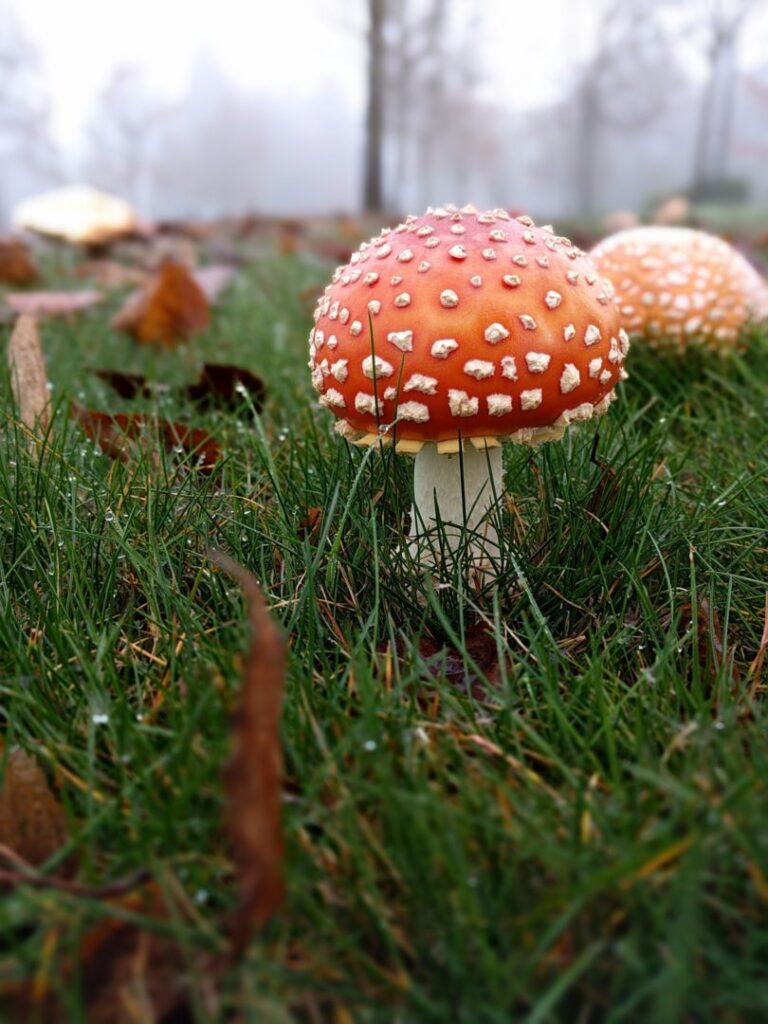
Eat this and you may be high as a kite but you won’t die.
Just because you see some mushrooms around your bonsai tree or other fungal activity, don’t assume it’s bad, it’s more likely to be a positive thing and shows a good balanced and healthy rhizosphere. Part of the trouble with bonsai trees is that, due to the way we keep them in tiny pots they are always under some form of stress. There is too much temperature fluctuation within the root system, too hot in summer and too cold in winter. It’s also hard to regulate the right moisture level in the soil and all but impossible to maintain the perfect nutrient balance. Not only that but our little pots, mostly do not allow sufficient root mass to exist to give us any buffer zone. Bonsai are then all too often messed with via, excess pruning, poor sighting in the garden and too infrequent ill advised re-potting and it’s easy to see bonsai trees spend their lives under considerable stress. Most can withstand this but it’s really easy to see one of our trees dropping on the wrong side of the line. When this happens the plant is a sitting duck just waiting for an infection of some sort.
Another factor to bear in mind is just how many non indigenous varieties we try to grow. Everywhere in the world plant P&D exist and most of them are kept at bay by the local environment or other controlling factors. Take a plant out of it’s natural environment and there is always a chance that natural control will be lost and P&D can become very difficult to control. Many plants are a bit like a fish out of water in a foreign land and the stress of this coupled with a lack of environmental control of P&D can spell trouble.
By far the most important factor in keeping P&D at bay is quality care of trees, ensuring they are hale and hardy and that stress levels are kept to a minimum thanks to quality horticulture and good nursery practice. A sick tree is normally the result of poor horticulture and once on the back foot it often seems all but impossible to recover a trees equilibrium. Of the many sick trees we encounter by far the most significant number are junipers. This beautiful and very common variety is so significantly misunderstood that 90% of the seriously poorly trees we encounter are some form of juniper. I would go so far as to say that probably over 90% of all junipers imported from Japan survive less than ten years at the hands of UK bonsai hobbyists. Most Japanese junipers are not suited to the UK climate with it’s cool mostly dry summers and long wet mild winters.
Over recent years there is a significant problem concerning the health of junipers that, by and large, has gone entirely unnoticed here. Thankfully it’s easily controlled once spotted and just getting on top of this seemingly insignificant fungal problem will significantly help junipers growing in Blightly. In fact this fungi is detrimental to all genus cupressus species.
If you have seen this on your junipers please read on….
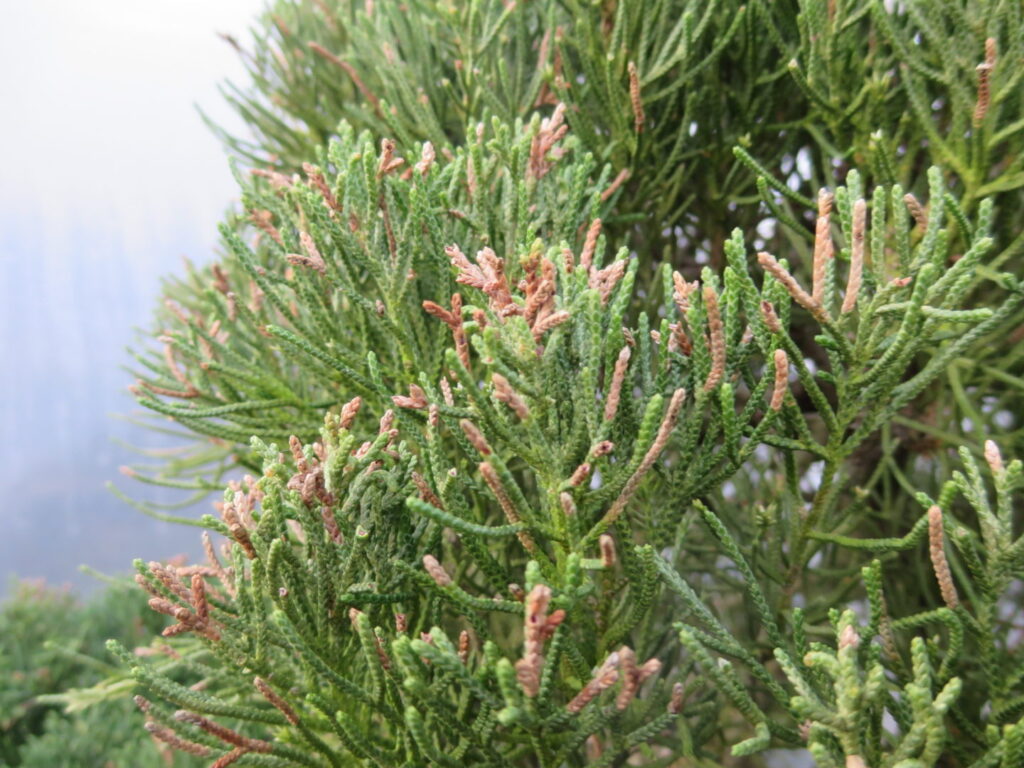
Whilst this may look like a simple case of scorch caused by summer heat or freezing winter winds it is in fact Phomopsis Tip Blight: This disease is caused by the fungus Phomopsis juniperovora and begins by infecting the tips of branches smaller than the diameter of a pencil, in particular new spring growth.
The new, immature growth becomes infected while the darker green, mature foliage remains resistant to infection. Infected twigs first become pale, then turn reddish-brown and finally become brown after death. Scraping away the bark will reveal a sharp line between discolored, dead wood and healthy wood. Watch for disease development during the spring or summer flush of new growth when warm, wet conditions are present.
Phomopsis blight is a common fungal disease and begins infecting young leaves at the tips of shoots. Small yellow spots appear first, and as the infection spreads, the leaves die, with the shoots fading to a light green and then reddish-brown and eventually dying back with an ash-gray color. Only new growth is killed, with dieback occurring in spring. Black fruiting bodies can form three to four weeks after infection.

Black fruiting bodies on dead foliage.
Repeated infections occur when temperatures are between 70 to 80 degrees, during periods of high humidity and when foliage is wet. Continuously wet foliage is needed for infection to occur. Areas with heavy shade and poor drainage allow for moist, slow-drying conditions ideal for the disease to thrive. Left untreated we have seen junipers die from this infection as the tree is progressively weakened over a few years. Thankfully we have found treatment to be very easy and also very effective.
For several years now we have been treating pomopsis as a matter of routine. So far we have not seen any evidence of the fungus in European sabina junipers but it has been observed in all other common bonsai juniper varieties including Japanese cultivars, garden varieties and cypress forms. We have had 100% success treating pomopsis using
Rose Clear Ultra. Spraying at the recommended strength we thoroughly soak junipers from above and beneath with a fine mist, allowing the product to dry on the foliage. This is done one in May, June and July, one month apart and has proven 100% successful in eradicating existing infections and preventing reinfection. A very simple spring time task and something easily accomplished. However ignore this seemingly insignificant fungal infection at your peril.
There is no need to go out and set your junipers on fire 😉
G.
Feb 16, 2018 | General
Just got back from a week away buying trees. A simple premise really, stockpile money all year, jump on a plane and come back without a penny. Sounds like the best job in the world right? This year I spent three times the price of my first house on hundreds of trees including some BEAUTIFUL Japanese specimens and top shelf yamadori. To be honest it’s absolutely exhausting, most folk spend hours choosing a tree to buy, try buying a hundred and fifty a day. All told we have the best stock of my life on the road right now. Stay tuned!
This being me things couldn’t really be that simple could they? Not content with buying my stock and catching up with some friends this turned into a trip from hell. I am antisocial to my core and hate crowds, even small gatherings and avoid most people like the plague. Whenever I get into a crowd I alway seem to end up with ‘the plague’. Last year I came away from Noelanders sick as an old dog. This year, on the second day of my trip I came down with what turned out to be a brutal bout of flu that I am still under the influence of, no doubt thanks to Ryanair. Poor Stuart, my long suffering best mate and travelling companion, what he had to endure was second only to what I had to. I think this is one of the first times I have had flu in my life and on the back of my other health woes this year things have not been good. Sorry Stu’, and thanks. Had Stuart not dragged me out of bed I would not have bought a single tree and would have still been languishing in the hotel room even now.
The trouble with owning a business is that you can’t go off sick. If you can’t stand there is sitting down work. If you can stand but can’t walk we will carry you to the work bench to get on. If you can’t stand or sit we will put you on the phone, in bed. It’s 22 years since I took a sick day, the small business owner has to work every day unless he’s dead which I am working on 😉
So I have just about managed to keep the momentum going and despite hacking, coughing and shivering with hot and cold flushes and nasty joint and muscle pains I did get these two knocked out over the last few days. Please send medals to the usual address 😉
First up is a privet we pulled out of a garden about 4 years back. This was the worst of five and just a chopped off stump. I knocked out the middle two years ago, selected a few branches and bent in the right general directions. Some wire and a little more carving and the tree has a future.
Next up was an elm I bought in Italy last year. Nobody wanted it so some work was called for. I hate having to work trees like this where someone has previously messed with them. The carving on this one was pretty pointless but with a little care I all but rescued it. I think this is going to come good in the end. In my book there is no such thing as a bad elm or privet, love ’em to bit’s, literally.
G.
